2016 SBL Diary: Days Three and Four
Day three began with a breakfast meeting for the NASSCAL board—about eight of the 12 of us were presenting at SBL, so the annual meeting presents us with a good opportunity to sit around a table together and talk about projects we have in the works. I chose a café in La Villita a little distance away from the hotels, thinking that it would be quiet and quick, but it seems that they were unprepared for, well, serving anyone, so we never managed to get breakfast, despite being there for 90 minutes. Nevertheless, the assembled board members discussed the first NASSCAL conference, books in our two series (Early Christian Apocrypha and Studies in Christian Apocrypha), and the establishment of some formal by-laws. Watch this space, and NASSCAL.com, for further news.
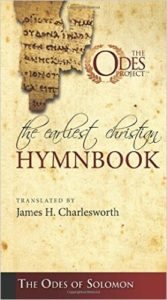 Between non-breakfast and lunch I visited the book display again and discovered that MNTA vol. 1 had sold out! Why oh why didn’t they bring enough copies to satisfy what clearly was a high demand? On the bright side, it’s an achievement to have the book sell out (mind you, they probably only brought three copies). I picked up only two books at the display this year (my expense account is on fumes): April DeConick’s The Gnostic New Age and James H. Charlesworth’s pocket book translation of the Odes of Solomon (The Oldest Christian Hymnbook: The Odes of Solomon).
Between non-breakfast and lunch I visited the book display again and discovered that MNTA vol. 1 had sold out! Why oh why didn’t they bring enough copies to satisfy what clearly was a high demand? On the bright side, it’s an achievement to have the book sell out (mind you, they probably only brought three copies). I picked up only two books at the display this year (my expense account is on fumes): April DeConick’s The Gnostic New Age and James H. Charlesworth’s pocket book translation of the Odes of Solomon (The Oldest Christian Hymnbook: The Odes of Solomon).
The second session of the Christian Apocrypha Section focused on apocryphal acts, a theme that, though not planned, came naturally out of the proposals we received. Michael Flexsenhar III (Rhodes College) spoke first with “Creating a Christian World: Martyrdom, Memory, and ‘Caesar’s Household’ in the Apocryphal Acts.” The paper takes as its starting point the conclusion of Philippians where Paul says “All the saints greet you, especially those of the emperor’s household” (4:22). Several apocryphal acts develop this notion with stories of slaves in Nero’s household converting to Christianity: in Acts of Paul, Patroculus’s conversion sets up Paul’s audience with Nero, the prologue to the Actus Vercellenses again places Paul with Nero’s slaves, and in the Martyrdom of Peter, Nero is upset that Peter dies before he can punish him for converting his slaves. Flexsenhar sees all of these traditions as efforts to establish an early Christian foothold in Rome, contributing to a “sacred geography” for the stories of the two chief apostles. Valentina Calzolari (University of Geneva) followed with “The Armenian Acts of Paul and Thecla.” Calzolari is the current president of l’AELAC (Association pour l’étude de la littérature apocryphe chrétienne) and this was her first appearance at SBL. We had some time over the weekend to discuss better co-operation between AELAC and NASSCAL in our respective publishing endeavours. Calzolari’s paper was a welcome entry into Armenian apocrypha, which few of us have the ability to study in any detail, though we will have more opportunity to do so in Calzolari’s forthcoming editions of the Thecla material in a volume in the Corpus Christianorum Series Apocryphorum (vol. 20 is Apocrypha Armeniaca, t. 1: Acta Pauli et Theclae – Miracula Theclae – Martyrium Pauli). The paper noted parallels between the Acts of Thecla in the Armenian Story of Rhipsime, which documents the conversion of Armenia, and the Martyrdom of Thaddaeus and Sandukht, which tells the story of Sandukht, the daughter of the king Sanatruk and the first Armenian martyr. Both Rhipsime and Sandukht are portrayed in ways very similar to Thecla, and it would appear that Thecla’s story was very influential in forming the account of Armenia’s conversion.
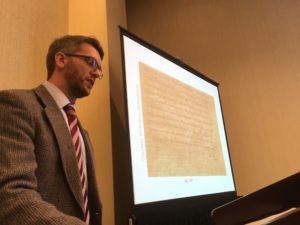
The third paper of the session was Jonathan Henry’s (Princeton University) “Thomas in Transmission: Some Noteworthy Witnesses to the Acts and Passion of Thomas.” Henry showed us images of several manuscripts of the Acts of Thomas, including an Irish palimpsest, which, dated 650 CE, is the second earliest witness we have to the text and a rare example of its transmission in the West. Most interesting, however, is Vallicellanus B 35, the only Greek MS of the text that includes the Hymn of the Pearl. Surprisingly, the unorthodox Acts of Thomas is nestled in this MS among the very orthodox writings of John Chrysostom, leading Henry to make the tantalizing statement, “We should not ask why the church is transmitting what it condemned but why they are condemning what they are transmitting.” He also brought our attention to images related to variant readings from the Acts of Thomas and noted that these types of witnesses do not show up in the critical editions.
Another excellent presentation about transmission was given by Ivan Miroshnikov (Helsingin Yliopisto – Helsingfors Universitet) in his paper, “Towards a New Edition of the Coptic Acts of Andrew and Philemon.” This rarely-examined text likely was written in Coptic but is extant also in Arabic and Ethiopic. The Coptic witnesses encompass five fragmentary MSS. The most interesting of these is designated MONB.DN, which is a compendia of Andrew apocrypha (containing Acts of Andrew and Matthias in the City of the Cannibals, Acts of Andrew and Philemon, Acts of Andrew and Paul, Acts of Andrew and Bartholomew, and Acts of Andrew and Peter), and MONB.DM, which is a collection of apostolic passion accounts. Miroshnikov established an origin of the text in a sixth-century monastic environment and illustrated how the length of readings in the text varies in the sources, making it difficult to determine the original form of the text. The final paper of the session was delivered by Sung Soo Hong, a student at the University of Texas at Austin. In “The Word of the Father Shall Be to Them a Work of Salvation”: Thinking with the Chaste Body of Thecla,” Hong examined three ways Thecla’s body functions in the text: as a demonstration of God’s salvific power (since Thecla does not experience martyrdom), as the embodiment of Paul’s beatititudes of self-control and resurrection, and as a display of God’s ability to protect his agents from harm.
The session concluded with an informal discussion of what the Christian Apocrypha Section might focus on next year. An appeal was made also to submit proposals for the 2017 SBL International in Berlin (call for papers; proposals are due by Feb. 22). The executive then headed off for their business meeting to take these suggestions and put them into action. It was decided that the four sessions next year will comprise: 1. a joint session with the Nag Hammadi and Gnosticism Section on the subject of “Coptic Apocrypha: Nag Hammadi and Beyond,” 2. a book review panel for MNTA vol. 1, and 3. and 4. open sessions, though with an appeal for papers on art and material culture, and apocryphal letters. The committee discussed also the possibility of a joint session with the Religious Competition Section in 2018.
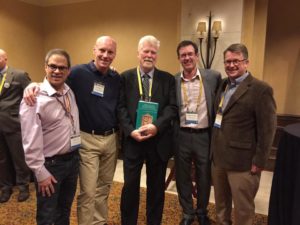
After the meeting, I caught up with fellow Canadian and good friend Phil Harland over dinner, and then we headed off to a reception for John Kloppenborg (Scribal Practices and Social Structures Among Jesus Adherents: Essays in Honour of John S. Kloppenborg, published by Peeters). He was presented with a Festschrift edited by four of his former students (one of whom is Phil). Kloppenborg was one of my instructors at the University of Toronto, though he was not my doctoral supervisor. He has been very supportive of my work over the years (including his participation on a review panel for MNTA vol. 1 at the 2016 CSBS). He approached me at the end of the reception to tell me about an exciting project that, if I accept the invitation (and if the publisher agrees that I should do it), will keep me very busy for the next few years.
Monday morning was free of sessions, so my wife and I took a water taxi trip to the Pearl Brewery. Little did we know it would take an hour to get there! So, we took a quick spin around the site, jumped on another water taxi back to the conference center, and managed to have enough time to change and get to the first afternoon session. Good thing, too, because I was one of the presenters. This third Christian Apocrypha Section session was a joint session with Digital Humanities. It opened with Brent Landau’s (University of Texas at Austin) “What No Eye Has Seen: Using a Digital Microscope to Produce a New Transcription of Papyrus Oxyrhynchus 210, a Possible Apocryphal Gospel.” Brent worked on a translation of P. Oxy. 210 for MNTA (yet another shameless plug). His presentation illustrated, on the one hand, the value of digital microscopes for resolving problematic readings in MSS, but emphasized also, on the other hand, that some readings cannot be resolved without firsthand viewing of the MS—demonstrated in several examples for P. Oxy. 210 where the folding over of fibres in the conservation process had obscured some of the letters. The two techniques, working together, can yield some significant results.
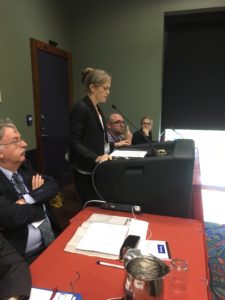
Janet Spittler (University of Virginia) and I followed Brent with our presentation on “Founding an Academic Society in the Digital Age: The North American Society for the Study of Christian Apocryphal Literature.” Janet spoke first, providing a history of the group and a tour of the membership directory portion of the NASSCAL site. She emphasized that NASSCAL was formed to encourage networking among Christian Apocrypha scholars, and the web site provides opportunities for “virtual conferencing” in a time when expense accounts are strained by the high cost of travel. Then I gave the audience a history and tour of the e-Clavis: Christian Apocrypha project.
Jennifer Barry (University of Mary Washington) introduced us to her developing project BandofAngels.org in “BandofAngels.org: Accessing Women’s History through the Digital Humanities.” The project, inspired by and named for Kate Cooper’s book Band of Angels: The Forgotten World of Early Christian Women, aims to provide online resources for the study of early Christian women’s stories and experiences. It is similar to Project Vox, which focuses on the lost voices of women in the histories of modern philosophy. For now, Barry’s project contains materials only on Thecla and the martyrs Perpetua and Felicitas. Unfortunately, it is not yet live, but it looks to be a promising pedagogical resource. Barry’s presentation included a tour of sites linked to her own, including Mapping the Martyrs, which gathers information on martyrdom accounts, including (for Christian Apocrypha enthusiasts) those of apostles.
Rounding out the session was James F. McGrath (Butler University) with his paper “Learning from Jesus’ Wife: The Role of Online Scholarship in Creating and Exposing a Forgery.” This was one of two papers this year on GJW; the other was “Dating Ancient Egyptian Papyri through Raman Spectroscopy: Concept and Application to Fragments of The Gospel of Jesus’s Wife and the Gospel of John” by James T. Yardley (Columbia University), Sarah Goler (Columbia University in the City of New York) and David Ratzan (New York University). For a discussion of this paper see James’ blogpost at Religion Prof. James’ own presentation covered some of the same ground as his contribution to the 2015 York Christian Apocrypha Symposium—i.e., online scholars declared GJW a forgery but it was slow and rigorous investigation that proved it to be so. He also mentioned how imitations of ancient manuscripts and artifacts can be helpful—as display items in museums or for use in classrooms—and how finetuning these imitations helps in identifying imitations designed for nefarious ends. Finally, James remarked that many of our authentic texts, such as the Gospel of Philip, have sensational contents; informing people of such texts could thus make it more difficult for forgers to dream up something that can capture the public’s attention.
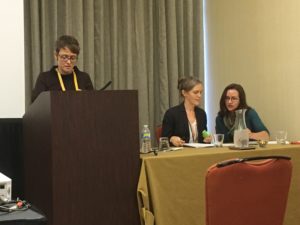
The final Christian Apocrypha session took place in the early evening and was focused loosely around the theme of “Violence and Healing in the Christian Apocrypha.” Janet Spittler opened the session with “Causality and Healing of Disease in the Acts of John.” The paper grew out of Janet’s forthcoming commentary on the Acts of John. Originally the paper was to cover a variety of maladies in the text but Janet’s presentation focused primarily on ch. 30 of the text in which elderly women of Ephesus suffer from a variety of illnesses because the townspeople are “slack.” Janet compared this diagnosis with descriptions by medical writers Chrysippus and Galen of the effects of slackness in the soul. The author of the Acts of John, then, is combining mind and body in the story of the Ephesian women, as well as other healing stories in the text—slackness in the soul gives them a fever, and the only prescription is more apostle.
In “Philosophical Foundations of (Self) Healing and Exorcism in the Pseudo-Clementine ‘Homilies’,” Patricia A. Duncan (Texas Christian University) noted similarities regarding the relationship between demons and illness in the Klementia (but not the Recognition) and Porphyry of Tyre, a third-century Neoplatonic philosopher. Both writers assert that demon-inflicted illness is related to contact with the material world; baptism and self-control helps to rid oneself of them. Judith Hartenstein (Universität Koblenz – Landau) followed Duncan with “Violence in the Gospel of Mary (BG 1).” The paper drew upon a new text from Codex Tchacos, the Book of Allogenes, to examine Gos. Mary’s confrontation of the soul with the violent powers that seek to restrain it on earth. The fourth presenter of the session, Annette Merz (Protestant Theological University Amsterdam Groningen), canceled her trip to San Antonio due to illness.
The session concluded with Matthias Geigenfeind’s (Universität Regensburg) “The Apocryphal Revelation of Thomas – Unique, but Underappreciated.” The paper was a text-critical examination of the apocalypse and thus did not cohere with the theme of the session. Nevertheless, it was an excellent study of the sources available to us on this text. Apoc. Thom. is relatively well-known in that it is typically included in the standard CA collections; however, the introductions tend to be obscure and rarely are they accompanied by a translation of the entire text. The apocalypse focuses on signs of the end time and comes in three forms: short form, a long form, and an abbreviated form comprised simply of the list of signs without attribution to Thomas. Likely it was composed in Latin and was very popular in the British Isles. Geigenfeind’s list of sources included a new MS from Kassel from the eighth century and, to my surprise, some fragments housed at the University of Toronto. Certainly the text is “underappreciated,” so perhaps we can help bring attention to this text by including it in a future volume of MNTA (was that another plug?).
And that brings my2016 SBL Diary to an end. After the final paper I headed out with my wife to soak in more of the sights and sounds of San Antonio, my second favourite annual meeting location (after the much-loved San Diego). San Antonio has fewer cultural charms than, say, Boston, but the weather can’t be beat, particularly to those of us traveling from the north. Keep an eye out for the 2017 call for papers and perhaps I will see you at next year’s sessions.
